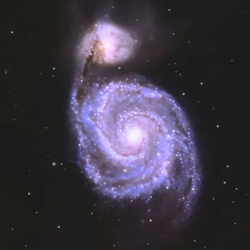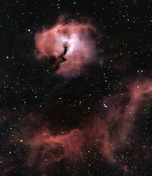Open Cluster
The Seagull Nebula
The Seagull Nebula is a sprawling region of open star clusters, glowing hydrogen gas, dark dust clouds, and scattered reflection nebulae. Its nickname comes from its distinct shape – suggesting a seagull in flight.
Click to read more. . .
May 2, 2025
517 words
3 min read
The Tadpole Nebula
The Tadpole Nebula (IC 410) gets its name from two striking tadpole-shaped clouds of dark dust that appear to be swimming towards the center. These “tadpoles” are dense streams of gas and dust, each stretching about 10 lightyears. Within them, new stars may be forming, hidden inside their thick cocoons.
Click to read more. . .
March 8, 2025
234 words
2 min read
The Skull and Crossbones Nebula
NGC 2467, also known as the “Skull and Crossbones Nebula,” is a region where new stars are being born. Some people think it looks like a grinning skull, while others see the face of a colorful mandrill.
Click to read more. . .
February 15, 2025
527 words
3 min read
The Butterfly Nebula
Near the bright star Sadr (grossly over exposed in the image) at the center of the Northern Cross lies the Butterfly Nebula. Its nickname comes from its intricate shape that somewhat resembles a butterfly with its delicate wings outstretched.
Click to read more. . .
December 1, 2024
388 words
2 min read
The Heart and Soul of the Night Sky
Is the heart and soul of our Galaxy located in the northern constellation Cassiopeia? Possibly not, but that is where two bright emission nebulas nicknamed Heart and Soul can be found – soulmates you could say. (Groan)
Click to read more. . .
December 8, 2023
492 words
3 min read
The Tulip Nebula
The Tulip Nebula is a glowing cloud of interstellar gas and dust and gets its name from the flower it appears to resemble in photographs. While a pretty sight itself, the Tulip has an interesting neighbor.
Click to read more. . .
October 15, 2023
280 words
2 min read
The Trifid Nebula
The Trifid Nebula, M20, is a beautiful gaseous cloud within which new stars are being born. It is one of several spectacular telescopic sights embedded in the summer and autumn Milky Way.
Click to read more. . .
October 1, 2023
333 words
2 min read
The Eagle Nebula
The Eagle Nebula M16, one of the brightest night sky nebulae, is an area where stars are actively forming. It is filled with dark regions and globules, including a peculiar dark column named the “Stellar Spire”. Of special note are the “Pillars of Creation” made famous by an early (1995) picture from the Hubble Space Telescope. The pillars and spire are collapsing clouds of dust and gas being sculpted by intense starlight from newly formed hot stars.
Click to read more. . .
September 15, 2023
613 words
3 min read
The Running Man Nebula
Following a stretch of poor weather, I got a chance to take the telescope out again the other night and got a good look at a somewhat whimsical space ghost - the Running Man Nebula.
Click to read more. . .
March 5, 2021
188 words
1 min read
A Celestial Valentine - The Heart Nebula
Although I made this picture back in December, I thought it would be appropriate to wait and post it on Valentine’s Day.
Click to read more. . .
February 14, 2021
285 words
2 min read
Some Celestial Whimsy
Here are three somewhat whimsical objects.
Click to read more. . .
January 20, 2021
455 words
3 min read
The Christmas Tree Cluster
Merry Christmas! In keeping with the holiday, here is a fresh look at one of my favorite objects, the Christmas Tree Cluster, NGC 2264.
Click to read more. . .
December 25, 2020
167 words
1 min read
The Trifid Nebula
The Trifid Nebula, M20, is a beautiful gaseous cloud within which new stars are being born. It is one of several spectacular telescopic sights embedded in the summertime Milky Way.
Click to read more. . .
August 14, 2020
263 words
2 min read
The Lagoon Nebula
The Lagoon Nebula, M8, is another remarkable region where new stars are being formed. It is a giant glowing cloud of interstellar gas lit up by nearby stars. It is divided by a dark lane of dust and it also contains an embedded cluster NGC 6530 whose stars have been newly formed from the nebular material.
Click to read more. . .
July 14, 2020
288 words
2 min read
The Eagle Nebula
M16, the Eagle Nebula, is one of several spectacular objects now coming into view in the summer evening sky. It has been made famous by the Hubble Space Telescope “Pillars of Creation” photograph - easily the most ubiquitous of all Hubble images.
Click to read more. . .
July 3, 2020
324 words
2 min read
The Pleiades
The Pleiades, also known as the Seven Sisters and Messier 45, are an open star cluster containing hot middle-aged stars in the constellation Taurus. It is among the star clusters nearest to Earth and is the cluster most obvious to the naked eye in the night sky. Most people can see the 6 or 7 brightest stars that form a smallish “dipper” – NOT to be confused with the Little Dipper (Ursa Minor constellation).
Click to read more. . .
June 23, 2020
279 words
2 min read
The Perseus Double Cluster
Two for the price of one! The Double Cluster consists of two open star clusters, known as H and Chi Persei (also called NGC 884 and 869).
Click to read more. . .
June 3, 2020
281 words
2 min read
Open Clusters
Scattered mostly along the Milky Way are stellar groupings called open clusters, randomly shaped families of mostly young, hot stars that are all gravitationally bound to each other. Most stars are born in such clusters, containing anything between perhaps twenty to a few thousand stars. All of the stars in a given cluster are about the same age, having formed together from the same nebula.
Click to read more. . .
May 27, 2020
245 words
2 min read
The Christmas Tree Star Cluster
The Christmas Tree Cluster was named for its triangular shape, formed by a cluster of very young stars, that looks like a tree in visible light. The bright variable star S Monocerotis (near the bottom) marks the base of the Christmas tree and lights up the nearby nebulosity.
Click to read more. . .
March 3, 2020
72 words
1 min read


